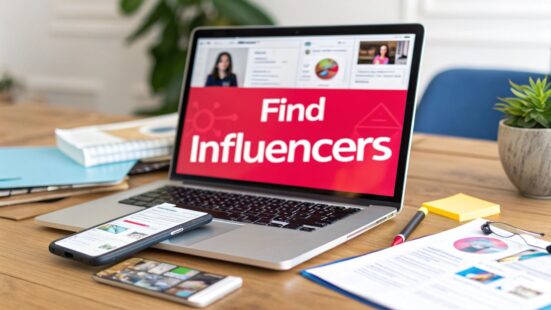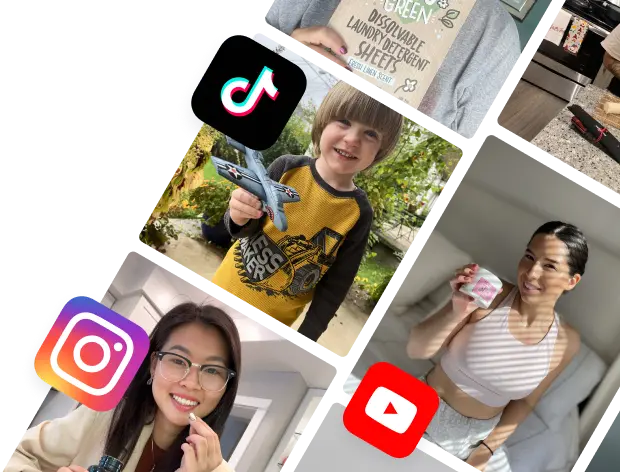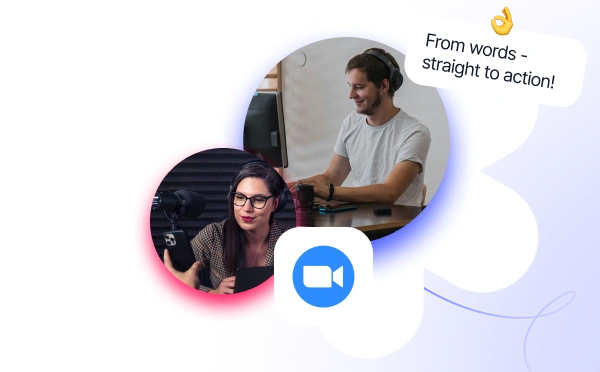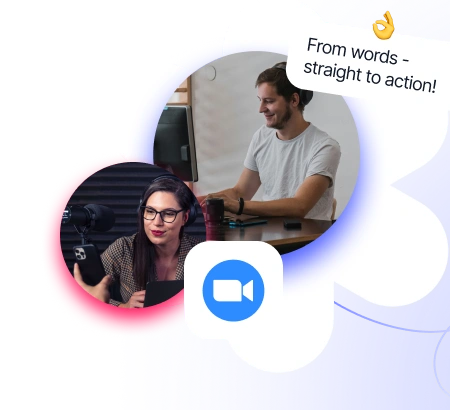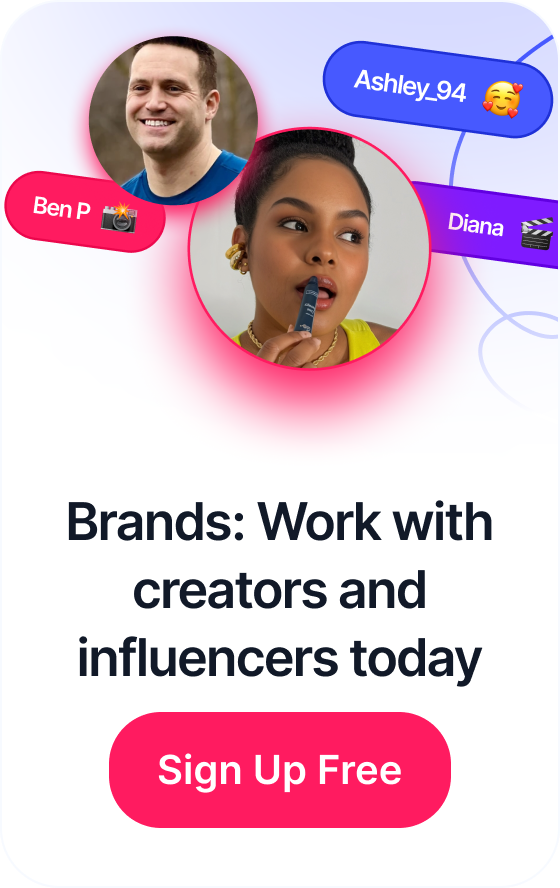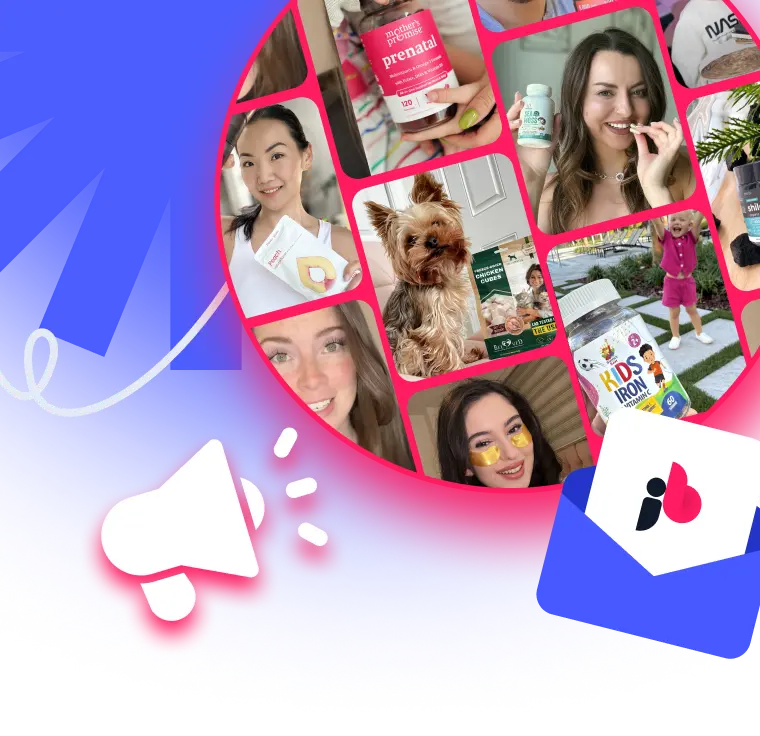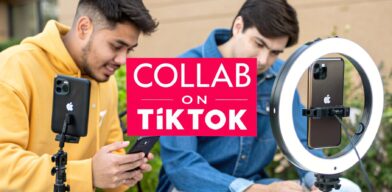 How to Collaborate on TikTok: Easy Strategies for Creators
How to Collaborate on TikTok: Easy Strategies for Creators
Finding the right influencer for your brand goes way beyond just scrolling through feeds and looking at follower counts. You need a real strategy, one that digs deep into authentic audience connection.
The best game plan involves building a detailed persona of your ideal influencer, using the right tools to find them, and then properly vetting each one to make sure they’re a perfect fit.
Table of Contents
Why Finding the Right Influencers Matters

Think of finding the right influencer less like renting an audience and more like earning their community’s trust. A great partnership isn't just a one-off sponsored post. It’s a collaboration that builds real, lasting credibility for your brand.
When an influencer’s values, their content style, and their audience are a mirror image of your own, their recommendation feels like getting advice from a good friend, not watching a commercial. That genuine connection is what actually moves the needle and delivers business results.
Moving Beyond Follower Counts
So many brands fall into the trap of chasing big follower numbers. But a massive audience doesn't automatically mean massive engagement or sales.
I’ve seen it time and time again: a micro-influencer with 15,000 super-engaged followers in a tight-knit niche can drive way more conversions than a macro-influencer with a million followers who just passively scroll by.
The secret sauce is audience alignment. The right partner has built a community that looks, acts, and thinks just like your ideal customer. That’s how you make sure your message doesn't just get seen, but actually heard.
The goal is to find a creator whose audience not only sees your product but is genuinely interested in it. This is the difference between broad awareness and targeted impact.
The Tangible ROI of Authentic Partnerships
The data doesn't lie—strategic partnerships work. The influencer marketing industry is on track to hit a staggering $32.55 billion in 2025, a huge leap from around $24 billion in 2024.
Why the explosive growth? Because it delivers a solid return. On average, brands see an ROI of $5.78 for every $1 spent, and some of the top-tier campaigns are pulling in as much as $20 for every dollar.
This ROI shows up in a few key ways:
- More Sales and Conversions: A recommendation from a trusted voice is often the final push someone needs to make a purchase.
- High-Quality User-Generated Content (UGC): You get a treasure trove of authentic photos and videos you can reuse across all your marketing channels.
- Stronger Brand Trust: When you team up with a respected person in a community, their credibility starts to rub off on your brand.
To see just how powerful these partnerships can be, check out these top successful celebrity endorsement examples. When you invest the time upfront to find that perfect match, the benefits will stick around long after the campaign is over, creating a ripple effect of trust and customer loyalty.
Building Your Ideal Influencer Persona
Before you even think about searching for influencers, you need to know exactly who you're looking for.
Jumping in without a clear target is like scrolling aimlessly through a crowded feed—you’ll get lost, waste time, and probably end up with a partnership that doesn’t connect. The fix? You need to build a detailed "influencer persona."
This isn't just about follower count. An influencer persona is your blueprint for the perfect partner. It outlines everything from their content style and tone of voice to their audience's demographics and how they engage. Think of it as a character sketch for your ideal brand ambassador.
For example, a minimalist, eco-friendly skincare brand wouldn't team up with an influencer known for loud, fast-fashion hauls. Their ideal persona would probably be a creator who focuses on sustainable living, clean beauty, and authentic, educational content. See the difference?
Defining Key Persona Traits
To build a persona that actually works, you need to get specific about the qualities that matter most to your brand. Don't just think about what they post; consider how they post and who they're talking to. This is where you move from a vague idea to a practical checklist.
Start by outlining these core characteristics:
- Tone of Voice: Is their style witty and humorous, or more inspirational and educational? Their voice should feel like a natural extension of your brand’s personality.
- Content Aesthetic: What does their feed look like? Is it polished and highly curated with professional photos, or is it more candid, raw, and relatable with a user-generated feel?
- Community Engagement: How do they interact with their followers? Look for creators who actually respond to comments and build a genuine community, not just those who post and disappear.
Your influencer persona acts as a filter. When a potential partner aligns with every trait on your list, you know you’ve found someone who can represent your brand authentically and effectively.
Aligning Personas with Influencer Tiers
Your persona should also factor in the different tiers of influencers. Each tier brings something different to the table, and your choice will depend entirely on what you want to achieve with your campaign.
A startup trying to build credibility in a small niche will have a very different persona than a global brand launching a blockbuster product.
Understanding these distinctions helps you narrow your search and focus your energy. You can align your persona directly with the kind of impact you want to make, ensuring you find influencers who are not just a good fit, but the right fit for your goals.
Influencer Tier Comparison
Here’s a quick breakdown to help you see how the different influencer tiers stack up. Each one offers unique advantages, so think about which aligns best with your persona and campaign objectives.
| Influencer Tier | Follower Count | Typical Engagement Rate | Best For |
|---|---|---|---|
| Nano-Influencer | 1k – 10k | 5% – 10% | Hyper-niche communities and building local trust. |
| Micro-Influencer | 10k – 100k | 3% – 5% | Driving high-quality engagement and conversions. |
| Macro-Influencer | 100k – 1M | 1% – 3% | Generating broad brand awareness and reach. |
| Mega-Influencer | 1M+ | < 1% | Massive, top-of-funnel campaign launches. |
As you can see, a smaller follower count often comes with much higher engagement. Don’t get distracted by big numbers alone; the real value is in finding the tier that best matches your specific needs.
Using Modern Tools for Influencer Discovery
Let’s be honest: manually scrolling through endless social media feeds to find influencers is a colossal waste of time. It’s no longer a practical way to find the right partners for your brand. The modern approach is way faster, smarter, and driven by hard data, all thanks to the new wave of discovery tools out there. These platforms go way beyond simple hashtag searches, offering deep, analytical insights that were once impossible to get.
AI-powered platforms have completely changed the game. Instead of just glancing at follower counts, you can now drill down and filter potential partners using incredibly specific criteria. Think about it—you can narrow your search based on an influencer's audience demographics, check out their past brand collaborations, and even gauge the overall sentiment of their content. This level of detail is what helps you find creators who are a perfect match for your brand’s goals, not just someone with a big following.
The Power of AI in Influencer Search
Bringing artificial intelligence into these tools has been a genuine breakthrough. In fact, by 2025, 66.4% of marketers say that AI integration directly improves their campaign outcomes. On top of that, 73% believe influencer marketing can be mostly automated if you have the right tech. AI platforms can sift through massive databases of influencers in seconds, predict how a campaign might perform, and even help automate your outreach. It makes the whole discovery process faster and far more accurate.
This infographic really drives home how a solid influencer persona—built on the alignment between your brand and your audience—is the real starting point for any successful, tool-based search.
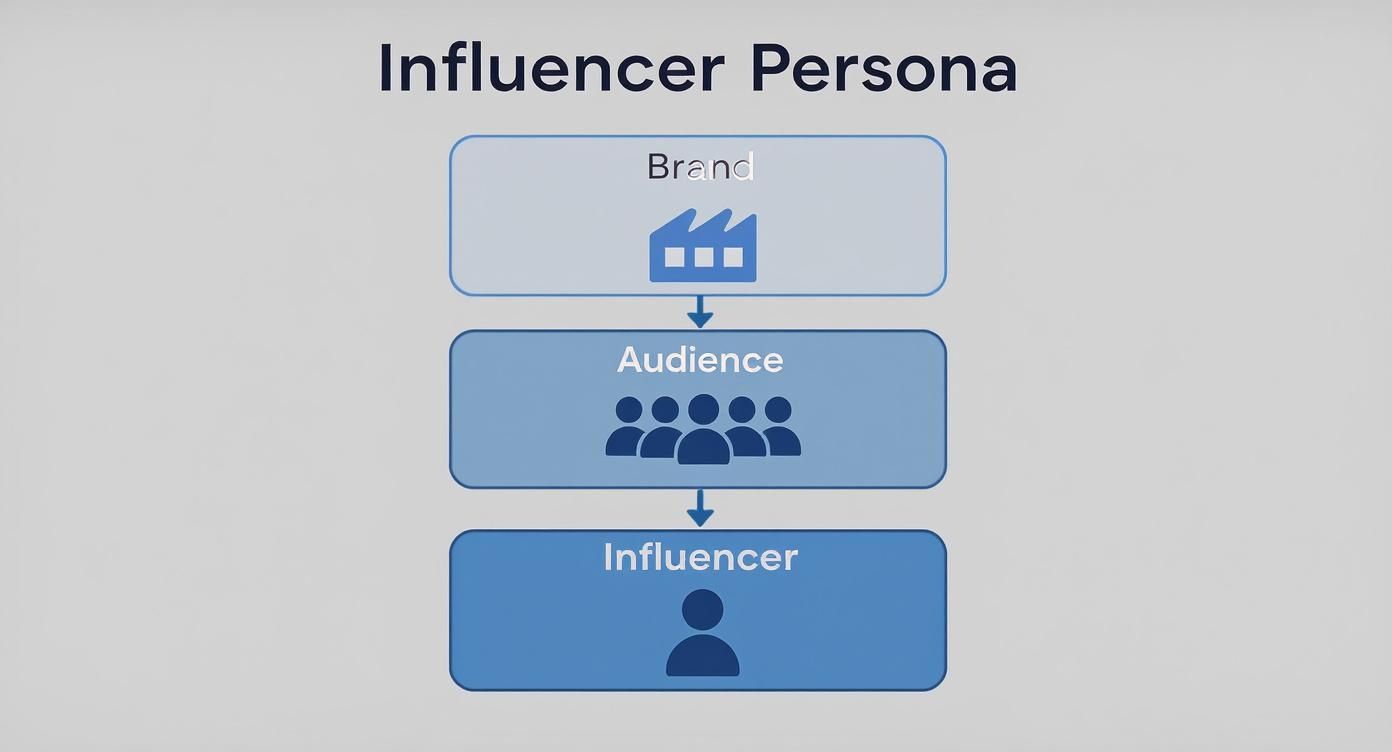
As you can see, your brand's core identity and what your audience truly needs have to be the filters you use. This is the crucial first step before you even start looking at creators.
Choosing the Right Tool for Your Needs
The market is flooded with a huge range of tools, from massive SaaS platforms to handy little browser extensions, and each one has its own strengths. To really get a handle on finding and picking creators, especially on a visual-heavy platform like Instagram, it helps to learn different search methods. That's why checking out resources on how to find Instagram influencers that fit your brand can give you some killer platform-specific tactics.
Here's a quick breakdown of the different types of tools and what they're good for:
- All-in-One Platforms: Tools like JoinBrands are built to manage everything from start to finish—discovery, vetting, campaign execution, and even payments. They’re a fantastic choice for brands that want to keep their entire influencer marketing workflow under one roof.
- Discovery-Focused Tools: Some platforms are hyper-focused on search and analytics. They give you incredibly deep dives into an influencer's audience health, true engagement metrics, and past performance.
- Browser Extensions: These are lightweight, simple tools that are perfect for quick, on-the-fly analysis while you're just browsing social media. They can pop up instant stats on profiles you come across organically.
The best tool isn't always the one with the most bells and whistles. It's the one that fits your team's workflow, your budget, and your campaign goals. It's about finding the tool that helps you uncover those hidden gems that manual searching would almost certainly miss.
Ultimately, using these modern solutions will save you countless hours and shift your strategy from pure guesswork to a data-backed science. For anyone wanting to dive deeper into this, you might find our guide on using influencer AI for your brand helpful. By leaning on technology, you can build targeted, high-quality lists of potential partners who are perfectly positioned to represent your brand.
How to Vet Influencers for Authenticity and Fit
So, you've got a list of potential influencers. The easy part is over. Now comes the real work: figuring out who is actually the right partner for your brand.
Finding an influencer is simple, but finding the right one means you have to go way beyond surface-level stats. This is about protecting your brand’s reputation and making sure your marketing dollars actually deliver a return.
A huge follower count is meaningless if the audience is full of bots or just completely disengaged. Your mission is to peel back the layers and look closely at three things: their content, their audience, and their past performance. This isn't optional—it's essential if you want a campaign that drives real results.
Analyzing Content Quality and Brand Alignment
First things first, does their content even feel like your brand? Take a good, long scroll through their feed—at least a few months' worth. You're looking for a consistent vibe, a clear tone, and values that don't clash with your own.
Imagine you’re a minimalist wellness brand. An influencer whose feed is a chaotic explosion of bright colors and non-stop product promos probably isn't your person, even if their numbers are massive. You need to be able to picture your product fitting into their world seamlessly, not sticking out like a sore thumb.
Here are a few things to keep an eye on:
- Visual Style: Do their photos and videos have a consistent look and feel? Is the quality high enough to make your brand look good?
- Caption Tone: Don't just skim the pictures—read their captions. Are they genuinely trying to connect with their audience, or is it all generic phrases and hashtag stuffing?
- Value Alignment: When you look at their content as a whole, does the message they're sending line up with your brand’s mission?
Digging into Audience Engagement and Authenticity
Alright, time to put on your detective hat. A big follower number can be bought, but genuine engagement is much harder to fake. Don't just glance at the likes and comments; you need to analyze their quality.
A sea of generic comments like “Great post!” or a stream of single emojis from the same handful of accounts is a major red flag. That often points to bots or engagement pods. What you want to see are real conversations. Are people asking questions? Are they sharing their own stories or tagging friends? That's the hallmark of a healthy, active community.
A micro-influencer with 15,000 followers and a comment section buzzing with real talk is infinitely more valuable than a macro-influencer with 200,000 followers and a wall of fire emojis.
Another crucial move is to check out their past sponsored posts. Search for hashtags like #ad or #sponsored and see how their audience reacted. Did engagement plummet compared to their regular posts? If it did, that’s a sign their followers are tired of ads. While you're at it, make sure they're disclosing their partnerships correctly. You can learn more about the official FTC guidelines for influencers to keep your brand and its partners compliant.
Spotting Red Flags
As you go through this process, keep your eyes peeled for warning signs that scream "bad partnership." Spotting these early will save you a world of headaches, wasted money, and potential damage to your brand's image.
Common Red Flags to Watch For:
| Red Flag | What to Look For | Why It Matters |
|---|---|---|
| Follower Spikes | Sudden, massive jumps in their follower count that can't be explained by a viral post. | This almost always means they bought fake followers, which offer zero value. |
| Low-Quality Comments | The comment section is filled with generic, repetitive phrases or comments from sketchy-looking accounts. | This signals a weak connection with their audience and likely bot activity. |
| Inconsistent Posting | You notice long, unexplained gaps between posts or a totally erratic content schedule. | This could mean they're unreliable or just not that committed to their platform. |
| Over-Saturation of Ads | Their feed looks more like a billboard than a personal page—it's just one sponsored post after another. | Their audience probably has ad fatigue, which means your campaign will perform poorly. |
Vetting isn't just a box-checking exercise. It’s the single most important step in finding influencers who will become true partners and drive the authentic results your brand deserves.
Crafting Outreach That Builds Real Partnerships

So, you've done all the digging—the searching, the vetting, the analyzing—and you've finally landed on a creator who feels like a perfect match. This next step is where the magic happens, or doesn't. Your first impression can make or break a potential partnership before it ever gets off the ground.
Let’s be honest, a generic, copy-paste message is the fastest ticket to the trash folder. Influencers, especially the ones with tight-knit communities, are drowning in collaboration requests every single day. If you want to stand out, your outreach has to show you've actually done your homework. It needs to prove you see them as a partner, not just a walking billboard.
Think of it this way: you're trying to build a relationship, not just process a transaction.
Personalize Your Pitch
The golden rule here is unbelievably simple: make it personal. Before you even think about writing that first sentence, take a few minutes to actually engage with their latest content. Go on, it won't take long.
Reference a specific post, video, or story that genuinely caught your eye. Mentioning something concrete—like, "Your recent video on sustainable morning routines really hit home with our team"—shows you're paying attention and not just blasting out a mass email. This tiny bit of effort immediately separates you from the 90% of brands sending out those lazy, generic pitches.
Your first message should feel less like a sales pitch and more like the beginning of a real conversation. Show them you appreciate their work and get their audience before you even bring up your product.
Create a Clear and Compelling Offer
Once you’ve made that personal connection, it's time to talk business. Creators are running a business, after all, so they appreciate clarity and professionalism. A vague request like "we'd love to collab" just creates confusion and more work on their end. Don't do it.
Instead, your pitch should clearly and concisely lay out the key details of what you have in mind. Be upfront about what you're offering and what you're asking for in return.
Your initial outreach should nail these points:
- A Clear Value Proposition: What's in it for them? Seriously. Spell out why a partnership with your brand would be a fantastic fit for their audience.
- Specific Deliverables: Are you thinking one Instagram Reel and three Stories? Be precise about the content you need. A well-defined scope helps them instantly understand the workload.
- Transparent Compensation: Whether it's a flat fee, free product, or an affiliate deal, be direct about payment right from the start.
Putting all your cards on the table builds trust from the get-go. It also makes the whole process smoother, because a detailed pitch can easily morph into a formal agreement down the line. If you need a hand figuring out what to include, check out our guide on creating a solid influencer brief template.
Respect Their Platform and Audience
Knowing the lay of the land is key. Instagram is still the top dog for marketers, with 79% of brands using it for their campaigns. That popularity means top creators are absolutely swamped with DMs and emails. The biggest age group of influencers is 25-34, making up 58% of the total, and they are sharp professionals who expect you to be, too.
Always use their preferred contact method. Most serious creators list a business email in their bio for a reason—use it. A DM should really be your backup plan, and if you use it, keep it short and sweet with the goal of moving the conversation over to email for the real details.
When you show respect for their process, you're starting the relationship off on a foundation of professionalism and mutual understanding. That's how great partnerships begin.
Common Questions About Finding Influencers
Let’s be honest, navigating the world of influencer marketing can feel like you're trying to solve a puzzle. You’ve got questions about budgets, creator tiers, and how to even start a conversation. It's totally normal.
Getting a handle on these key areas is what separates a shaky campaign from a successful one. Let's clear up some of the most common questions you'll run into.
How Much Should I Pay Influencers?
There’s no magic number here. Influencer compensation is all over the map, and it depends on everything from follower count and engagement to the industry and what you're actually asking them to do.
You might have heard the old "one cent per follower" rule—like paying $100 for someone with 10,000 followers. That’s a decent starting point to wrap your head around, but it’s pretty outdated. It just doesn't capture the real value a creator brings.
A much smarter way to approach it is by looking at a few things together. First, ask for their media kit. This will show you their standard rates and give you a baseline. Then, weigh that against their actual engagement metrics and how much work you’re asking for.
Don't forget, a lot of creators, especially in the nano and micro tiers, are totally open to product-only collaborations. This works best if your product has a solid retail value and is a perfect match for their audience. The goal is always to find a middle ground that feels like a win for both of you.
Should I Work with Micro or Macro Influencers?
The answer to this one comes down to one thing: your campaign goals. There's no single "best" choice, because each tier of influencer brings something different to the table.
Macro-influencers are your heavy hitters for getting massive brand awareness, and fast. Their huge reach is perfect for putting your brand in front of a ton of people all at once. Think new product launches or big company news.
On the flip side, micro-influencers often punch way above their weight class with engagement. They tend to have incredibly dedicated, niche audiences. This makes them absolute gold for driving actual sales and building genuine trust with a community.
My favorite approach? A hybrid strategy. It's incredibly effective. Kick things off with a macro-influencer to make a huge splash, then bring in a team of micro-influencers to keep the momentum going and drive that deeper, more authentic engagement.
Take a hard look at your budget and what you’re trying to achieve. That will tell you where you’ll get the best bang for your buck.
What Is the Best Way to Contact an Influencer?
When it's time to reach out, always go for the most professional route you can find. Most serious influencers will have a business email right in their social media bio. Make that your first stop. Always. Email gives you the space to lay out a proper, detailed pitch that won't get buried in a sea of notifications.
If you can't find an email, a direct message (DM) is the next best thing. When you slide into their DMs, keep it short, sweet, and to the point. Your only job is to get them interested enough to move the real conversation over to email.
Whatever you do, don't leave comments on their posts like, "Hey, check your DMs!" It looks unprofessional and, frankly, desperate. Plus, it's super easy to miss. No matter how you reach out, personalization is the key to getting noticed and getting a "yes."
Ready to stop scrolling and start connecting with the perfect creators? JoinBrands offers an all-in-one platform to find, manage, and scale your influencer campaigns with ease. Discover your next brand ambassador today.
